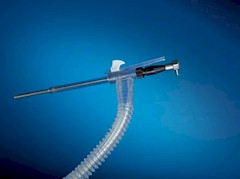Endometrial Ablation & The HTA System
The HTA® System for Menorrhagia
HTA® allows minimally invasive treatment of excessive menstrual bleeding. Because the treatment relies on the circulation of heated saline, which fills the uterine cavity, it has the unique ability to treat even those women whose uterine cavities have abnormal shapes and also some with fibroids.

Hydroderm ablation device
 |
The Procedure
- The gynecologist inserts a small probe into the uterus that includes a tiny telescope to allow visualization of the uterine cavity while room temperature saline solution is circulated through the uterine cavity.
- The fluid is then gradually heated to treat the lining of the uterus (the endometrium); the change in color of the lining shows the effect of the treatment.
- At the completion of the treatment phase, cool saline solution replaces the heated fluid and then the instrument is removed.
Frequently Asked QuestionsQ. What is the HTA System?
A. The HTA System is a device that allows your gynecologist to perform endometrial ablation on an outpatient basis. This outpatient procedure allows your doctor to insert a probe into your uterus that includes a tiny telescope for viewing the lining of the uterus. Heated saline is circulated and is intended to destroy the lining of the uterus, even in a larger or unusually shaped uterus, to eliminate or reduce bleeding to normal levels or less.Q. How will I be evaluated to determine if endometrial ablation with the HTA System is the right procedure for me?
A. Your gynecologist will do some pre-treatment tests that may include a Pap smear, an ultrasound, or a hysteroscopy (look inside the uterus with a tiny telescope) to see why you are having excessive menstrual bleeding.Q. How does the HTA System work?
A. First, your cervix will be slightly dilated to allow the introduction of the telescope through the vagina, into the cervix and then into the uterus. This gives your gynecologist a view of the inside of your uterus to assure proper positioning. Then, your uterus will be filled with room temperature saline solution to gently clean and flush the uterus. The fluid will be gradually heated to 90ºC and circulated in the uterus for ten minutes in order to treat the endometrium (lining of the uterus). When the treatment is complete, the uterus will be flushed with room temperature saline to cool the uterus and the probe. Your uterine lining has been treated and will slough off similar to a menstrual period over the next few weeks.Q. Will I feel anything during the procedure?
A. Your physician may give you pain medication before the procedure to minimize cramping during or after the procedure. You and your physician will decide what anesthesia will be best for you to receive during the procedure. Your choices are to be fully asleep so you won’t feel anything during the procedure, or to receive some medication to be sedated (sleepy) during the procedure or to receive only a local anesthesia injection and be fully awake. If you choose to be awake, you may feel some discomfort, such as mild cramping, during the procedure.Q. Is the endometrial ablation procedure painful?
A. Endometrial ablation can be performed under local anesthesia with a Novacaine-type medication, local anesthesia combined with a sedative, regional anesthesia (epidural block) or general anesthesia (you are completely asleep). Many women experience cramps for up to 1 day after the operation which can be treated with pain medication.Q. What should I expect after treatment with the HTA System?
A. You should be able to return home on the day of your procedure. You may experience some cramping that should go away by bedtime. Most women should be able to return to normal activities the next day. You will probably have a pink or yellow watery discharge for a few weeks after your treatment. If you experience two days of heavy bleeding, abdominal or pelvic pain, a fever, or pain that increases over time beyond 24 hours after the procedure, call your physician.Q. What should I expect after I go home?
A. Most women should be able to return to normal daily activities the next day. You should speak with your physician about the resumption of sexual activity. Most patients experience a pink or yellow watery discharge for a few weeks or longer after the procedure. You should not use tampons for up to seven days after the procedure to reduce the potential risk of infection. Your monthly menstrual bleeding may be heavy for a while after the treatment as a part of the healing process, and should improve after a few months.Q. What are the risks of treatment with the HTA System?
A. Treatment with the HTA System may involve some rare but potential risks that include perforation (creation of a hole) in the wall of the uterus, a hot fluid leakage onto the bowel or other internal organ burn or leakage of hot fluid into the cervix or vagina. Collection of blood and/or tissue in the uterus post procedure (hematometra) may occur and may require another outpatient procedure to correct the problem.